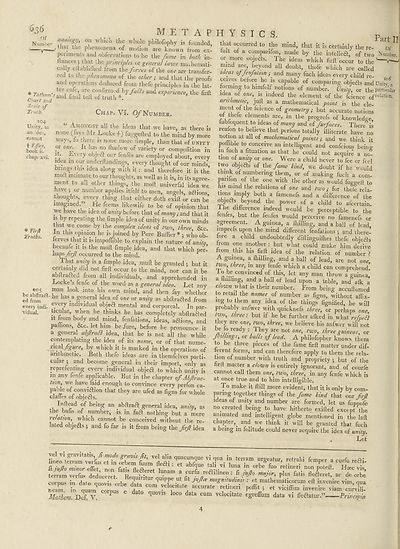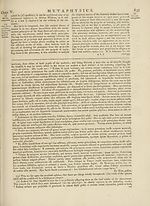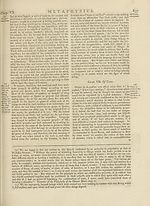Encyclopaedia Britannica, or, a Dictionary of arts, sciences, and miscellaneous literature : enlarged and improved. Illustrated with nearly six hundred engravings > Volume 13, MAT-MIC
(682) Page 636
Download files
Complete book:
Individual page:
Thumbnail gallery: Grid view | List view

*' Tatham'
Chart nrd
Sr ale of
Truth
M E T A P
analogy, on wlncli the whole philofophy is founded,
, that the phenomena of motion are known from ex¬
periments and obfervations to be the fume in both in-
itances; that principles ox genera/ laws mavhemati-
eally cdaoliilieo from Uw. forces of the one are transfer¬
red to the phenomena of the other; and that the proofs
ana operations deduced from thefe principles in the lat¬
ter cafe are confirmed hy fuels and experience, the firft
s and final teil of truth *.
Chap. VI. 0/rNumber.
204
Unity, as
an de ,
cannot
f EJay,
book ii.
chap. xvi.
* Tirft
Truths.
*05
be abftracft
ed from
ever} indi¬
vidual.
Amongst all the ideas that we have, as there is
none (fays Mr Locke f) fuggefted to the mind by more
wayp fo there is none more limple, than that of unity
.or one- ^ Iias no fhadow of variety or compofition in
it. Every objedf our fenfts are employed about, every
idea in our underilandings, every thought of our minds
brings tins idea along with it : and therefore it is the’
moil intimate to our thoughts, as well as it is, in its agree¬
ment to all other things, the moft univerfal idea we
have ; or number applies itfelf to men, angels, adions,
thoughts, every thing that either doth exill or can be
imagined.” _ He feems likewife to be of opinion that
we have the idea of unity before that of many; and that it
is by repeating the Ample idea of unity in our own minds
that we come by the complex ideas of two, three &c
In this opinion he is joined by Pere Bufher* ; who ob-
Jerves that it is impoflible to explain the nature oi unity
becaufe it is the moll fimple idea, and that which per¬
haps /fry? occurred to the mind. 1
I hat unity is a fimple idea, muft be granted ; but it
certainly did not firft occur to the mind, nor can it be
abltracred from ail individuals, and apprehended in
.Locke s fenfe of the word as a general idea. Let any
man look into his own mind, and then fay whether
he has a general idea of one or unity as abftraded from
every individual objea mental and corporeal. In par¬
ticular, when he thinks he has completely abftra£ied
it from body and mind, fenfations, ideas, adions, and
pamons, &c, let him be Jure, before he pronounce it
a general abfraB idea, that he is not all the while
contemplating the idea, of its name, or of that nume-
x\c?t\ figure, by which it is marked in the operations of
arithmetic. Both thefe ideas are in themfelves parti¬
cular^; and become general in their import, only as
reprefenting every individual objeft to which unity is
in any fenfe applicable. But in the chapter of Abfrac¬
tion, we have laid enough to convince every perfon ca¬
pable of convidion that they are ufed as figns for whole
clafies of objeds.
In dead of being an abftrad general idea, unity, as
the bafis of number, is in fad nothing but a mere
relation,' which cannot be conceived without the re¬
lated objeds ; and fo far is it from being the frjl idea
H Y S ^ S’ Part II
that occurred to the mind, that it is certainly the re-
iult oi a companion, made by the intelled, of two
or. more objeds. 1 he ideas which firft occur to the
mind are beyond all doubt, thofe which are called
laeas oj fenfation ; and many fuch ideas every child re¬
ceives beiore he is capable of comparing objeds and Unity^a
forming to lumfelf notions of number. Unity, or the Particular
idea of one,' is indeed the element of the leience oflelation>
arithmetic, juft as a mathematical point is the ele¬
ment of the icience of geometry; but accurate notions
of thefe elements are, in the progrefs of knowledge
lubiequent to ideas of many and of furfaces. There is
reafon to believe that perfims totally illiterate have no
notion at all of mathematical points ; and we think it
poliib e to conceive an intelligent and confcious beitm
in luch a fituation as that he could not acquire a no¬
tion of unity or one. Were a child never to fee or feel
two objeds of the fame kind, we doubt if he would
think of numbering them, or of making fuch a com¬
panion of the one with the other as would fugf/eft to
his mind the relations of one and two ; for thele rela¬
tions imply both a famenefs and a difference of the
objeds. beyond the power of a child to afeertain.
Ihe difference indeed would be perceptible to the
ienies, but the fenfes would perceive no famenefs or
agreement. A guinea, a ihilling, and a bail of lead,
impreis upon the mind different fenfations ; and there¬
fore a child undoubtedly diftinguiihes thefe obieds
trom one another : but what could make him derive
from this his firft idea of the relation of number >
A guinea, a ihilling, and a ball of lead, are not one
two three, in any ienfe which a child can comprehend!
lo be. convinced of this, let any man throw a guinea,
a {lulling, and a ball of lead upon a table, and aik a
clown what is their number. From being accuftomed
to retail the names of number as figns, without affix¬
ing to them any idea of. the things fignified, he will
probably anfwer with quicknefs three, or perhaps one,
two, three: but if he be further aiked in what refpeEl
they are one, two, three, we believe his anfwer will not
be io ready :, They are not one, two, three guineas, or
JhiUmgs, or balls of lead. A philofopher knows them
to be three pieces of the fame firft matter under dif-
ferent forms, and can therefore apply to them the rela¬
tion Ox number with truth and propriety ; but of the
firft matter a clown is entirely ignorant, and of courfe
cannot call them one, two, three, in any fenfe which is
at once true and to him intelligible.
I o make it ftill.more evident, that it is only by com¬
paring together things of the fame kind that our frjl
ideas of unity, and number are formed, let us fuppofe
no.created being to have hitherto exifted except the
animated and intelligent globe mentioned in the laft
chapter,, and. we think it will be granted that fuch
a being in folitude could never acquire the idea of unity.
, Let
vwfuf eufmbXfuumVflea?-qrtaTbr1UeVtirna-ir " “r£eranir’ r.etraH f, mP''r a curfu refli-
terram TL a “e
=r i i
Malm, Def V, P d qU0T‘S loco dala cum vel°atate 'greffum data vi fca*tur.” Princfr,
4
Chart nrd
Sr ale of
Truth
M E T A P
analogy, on wlncli the whole philofophy is founded,
, that the phenomena of motion are known from ex¬
periments and obfervations to be the fume in both in-
itances; that principles ox genera/ laws mavhemati-
eally cdaoliilieo from Uw. forces of the one are transfer¬
red to the phenomena of the other; and that the proofs
ana operations deduced from thefe principles in the lat¬
ter cafe are confirmed hy fuels and experience, the firft
s and final teil of truth *.
Chap. VI. 0/rNumber.
204
Unity, as
an de ,
cannot
f EJay,
book ii.
chap. xvi.
* Tirft
Truths.
*05
be abftracft
ed from
ever} indi¬
vidual.
Amongst all the ideas that we have, as there is
none (fays Mr Locke f) fuggefted to the mind by more
wayp fo there is none more limple, than that of unity
.or one- ^ Iias no fhadow of variety or compofition in
it. Every objedf our fenfts are employed about, every
idea in our underilandings, every thought of our minds
brings tins idea along with it : and therefore it is the’
moil intimate to our thoughts, as well as it is, in its agree¬
ment to all other things, the moft univerfal idea we
have ; or number applies itfelf to men, angels, adions,
thoughts, every thing that either doth exill or can be
imagined.” _ He feems likewife to be of opinion that
we have the idea of unity before that of many; and that it
is by repeating the Ample idea of unity in our own minds
that we come by the complex ideas of two, three &c
In this opinion he is joined by Pere Bufher* ; who ob-
Jerves that it is impoflible to explain the nature oi unity
becaufe it is the moll fimple idea, and that which per¬
haps /fry? occurred to the mind. 1
I hat unity is a fimple idea, muft be granted ; but it
certainly did not firft occur to the mind, nor can it be
abltracred from ail individuals, and apprehended in
.Locke s fenfe of the word as a general idea. Let any
man look into his own mind, and then fay whether
he has a general idea of one or unity as abftraded from
every individual objea mental and corporeal. In par¬
ticular, when he thinks he has completely abftra£ied
it from body and mind, fenfations, ideas, adions, and
pamons, &c, let him be Jure, before he pronounce it
a general abfraB idea, that he is not all the while
contemplating the idea, of its name, or of that nume-
x\c?t\ figure, by which it is marked in the operations of
arithmetic. Both thefe ideas are in themfelves parti¬
cular^; and become general in their import, only as
reprefenting every individual objeft to which unity is
in any fenfe applicable. But in the chapter of Abfrac¬
tion, we have laid enough to convince every perfon ca¬
pable of convidion that they are ufed as figns for whole
clafies of objeds.
In dead of being an abftrad general idea, unity, as
the bafis of number, is in fad nothing but a mere
relation,' which cannot be conceived without the re¬
lated objeds ; and fo far is it from being the frjl idea
H Y S ^ S’ Part II
that occurred to the mind, that it is certainly the re-
iult oi a companion, made by the intelled, of two
or. more objeds. 1 he ideas which firft occur to the
mind are beyond all doubt, thofe which are called
laeas oj fenfation ; and many fuch ideas every child re¬
ceives beiore he is capable of comparing objeds and Unity^a
forming to lumfelf notions of number. Unity, or the Particular
idea of one,' is indeed the element of the leience oflelation>
arithmetic, juft as a mathematical point is the ele¬
ment of the icience of geometry; but accurate notions
of thefe elements are, in the progrefs of knowledge
lubiequent to ideas of many and of furfaces. There is
reafon to believe that perfims totally illiterate have no
notion at all of mathematical points ; and we think it
poliib e to conceive an intelligent and confcious beitm
in luch a fituation as that he could not acquire a no¬
tion of unity or one. Were a child never to fee or feel
two objeds of the fame kind, we doubt if he would
think of numbering them, or of making fuch a com¬
panion of the one with the other as would fugf/eft to
his mind the relations of one and two ; for thele rela¬
tions imply both a famenefs and a difference of the
objeds. beyond the power of a child to afeertain.
Ihe difference indeed would be perceptible to the
ienies, but the fenfes would perceive no famenefs or
agreement. A guinea, a ihilling, and a bail of lead,
impreis upon the mind different fenfations ; and there¬
fore a child undoubtedly diftinguiihes thefe obieds
trom one another : but what could make him derive
from this his firft idea of the relation of number >
A guinea, a ihilling, and a ball of lead, are not one
two three, in any ienfe which a child can comprehend!
lo be. convinced of this, let any man throw a guinea,
a {lulling, and a ball of lead upon a table, and aik a
clown what is their number. From being accuftomed
to retail the names of number as figns, without affix¬
ing to them any idea of. the things fignified, he will
probably anfwer with quicknefs three, or perhaps one,
two, three: but if he be further aiked in what refpeEl
they are one, two, three, we believe his anfwer will not
be io ready :, They are not one, two, three guineas, or
JhiUmgs, or balls of lead. A philofopher knows them
to be three pieces of the fame firft matter under dif-
ferent forms, and can therefore apply to them the rela¬
tion Ox number with truth and propriety ; but of the
firft matter a clown is entirely ignorant, and of courfe
cannot call them one, two, three, in any fenfe which is
at once true and to him intelligible.
I o make it ftill.more evident, that it is only by com¬
paring together things of the fame kind that our frjl
ideas of unity, and number are formed, let us fuppofe
no.created being to have hitherto exifted except the
animated and intelligent globe mentioned in the laft
chapter,, and. we think it will be granted that fuch
a being in folitude could never acquire the idea of unity.
, Let
vwfuf eufmbXfuumVflea?-qrtaTbr1UeVtirna-ir " “r£eranir’ r.etraH f, mP''r a curfu refli-
terram TL a “e
=r i i
Malm, Def V, P d qU0T‘S loco dala cum vel°atate 'greffum data vi fca*tur.” Princfr,
4
Set display mode to:
![]() Universal Viewer |
Universal Viewer | ![]() Mirador |
Large image | Transcription
Mirador |
Large image | Transcription
Images and transcriptions on this page, including medium image downloads, may be used under the Creative Commons Attribution 4.0 International Licence unless otherwise stated. ![]()
| Permanent URL | https://digital.nls.uk/192692913 |
|---|
| Attribution and copyright: |
|
|---|
| Description | Ten editions of 'Encyclopaedia Britannica', issued from 1768-1903, in 231 volumes. Originally issued in 100 weekly parts (3 volumes) between 1768 and 1771 by publishers: Colin Macfarquhar and Andrew Bell (Edinburgh); editor: William Smellie: engraver: Andrew Bell. Expanded editions in the 19th century featured more volumes and contributions from leading experts in their fields. Managed and published in Edinburgh up to the 9th edition (25 volumes, from 1875-1889); the 10th edition (1902-1903) re-issued the 9th edition, with 11 supplementary volumes. |
|---|---|
| Additional NLS resources: |
|

